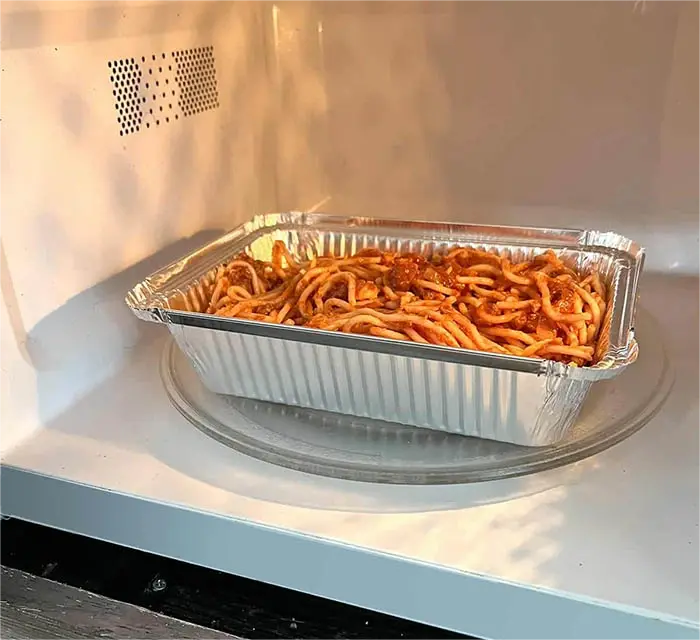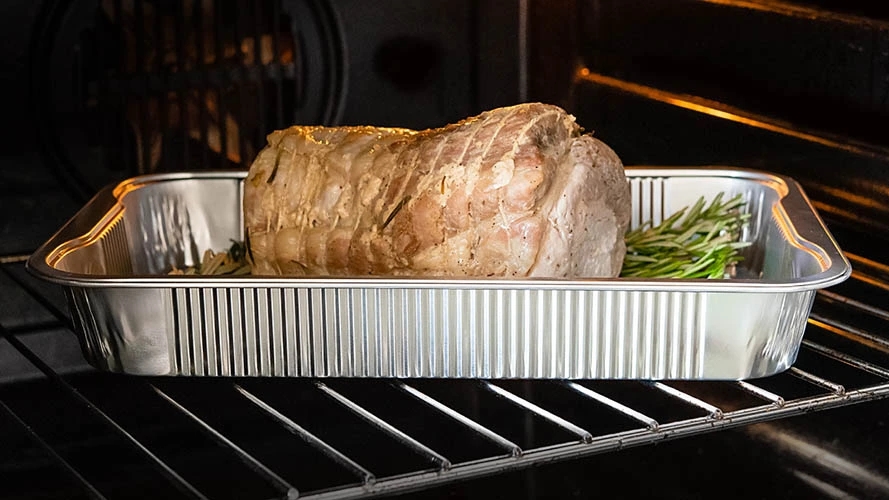Aluminum trays are lightweight, long-lasting trays that are used for packaging, baking, and serving. It is comprised of aluminum foil and has high thermal conductivity and anti-corrosion qualities, making it popular in the food business and at home.

Aluminum trays are classified into three types based on their reusability:
Disposable aluminum tray: This type of tray is usually used for food packaging, such as takeaway lunch boxes, barbecue trays, etc. Typically made from thin aluminum foil, they are cheap and easy to use and handle.
Reusable aluminum tray: This type of tray is commonly used for baking and serving food items such as baking sheets, oven trays, cake pans, etc. They are made of thicker aluminum foil and can be used multiple times, but are more expensive.
Aluminum Tray Sizes Division:
Generally speaking, the dimensions of aluminum trays include diameter, depth and thickness.
Aluminum trays can be divided into different types depending on their size. For example, aluminum foil disks with a diameter less than 10 cm, a depth less than 2 cm, and a thickness less than 10 microns can be used for food packaging; a diameter between 10 cm and 30 cm, a depth between 2 cm and 5 cm, and a thickness of 10 microns Aluminum trays between 30 microns and 30 microns can be used in baking and ovens; aluminum trays with a diameter greater than 30 centimeters, a depth greater than 5 centimeters, and a thickness above 30 microns can be used in industrial production and other fields.

Details Of Aluminum Trays Production Raw Materials:
Aluminum foil with a thickness ranging from 0.03mm to 0.2mm is commonly used in the manufacture of aluminum food trays. This type of aluminum foil is commonly referred to as “工业铝箔” or “medium-thickness aluminum foil,” and its grades mostly comprise 8011, 3003, 1235, and so on.

8011 aluminum foil is a typical aluminum alloy material with good ductility, corrosion resistance, and weldability. It can be used to make food packaging, medicinal packaging, building materials, and so on. 3003 铝箔 is an aluminum alloy with a high manganese concentration. It is corrosion resistant and weldable, making it ideal for food packaging, electrical product casings, and other applications. 1235 aluminum foil is a pure aluminum material with good ductility and conductivity. It is suitable for making capacitor foils, battery shells, etc.
Aluminum Trays Production Process:
Raw material preparation: The main raw material of aluminum foil trays is aluminum foil rolls, which are usually made of aluminum ingots or aluminum alloy ingots. These raw materials need to be processed by smelting, rolling and other processes to obtain the required aluminum foil rolls.
Cutting: Aluminum foil rolls must be trimmed to the required size and form. To ensure cutting accuracy and efficiency, this stage is frequently handled by automated cutting machines.
Forming: Aluminum foil rolls are formed by forming machines into various forms of pallets. To maintain the strength and stability of the pallet, forming machines often use stamping or deep drawing methods.
Surface treatment: Aluminum trays frequently need to have their surfaces treated in order to increase their corrosion resistance and visual appeal. In order to suit client needs, surface treatment typically entails cleaning, spraying, printing, and other procedures.
Inspection and packaging: After aluminum pans production is complete, it is necessary to examine the product’s quality and package it. To make sure the pallet fits the needs of the customer, quality inspection frequently involves visual inspection, dimensional measurement, strength testing, etc. To protect the product from damage during storage and transportation, packaging is frequently done in cartons or pallets.
Advantages of Aluminum Trays:
- Light and easy to carry: Compared with traditional wooden or plastic pallets, aluminum baking pans are lighter in weight, easier to handle and transport, and can reduce labor and material costs.
- Good anti-corrosion properties: Aluminum pans have excellent anti-corrosion properties and are not susceptible to moisture or rust. They can be used in humid or harsh environments to ensure the safety of goods.
- Environmental protection and energy saving: Aluminum foil pans can be reused and do not need to be replaced as frequently as wooden or plastic pallets, reducing the waste of resources and environmental pollution.
- Safety and hygiene: Aluminum foil pans have a smooth surface and are easy to clean and disinfect, ensuring the hygiene and safety of goods.
- Strong customizability: Aluminum pans can be customized according to customer needs, and pallets of various sizes and shapes can be produced to meet the needs of different industries.
Safety Considerations With Aluminum Trays:
It’s crucial to take safety precautions into account when utilizing aluminum trays. Prior doing anything else, be sure the aluminum cooking pans you use are made of food-grade aluminum material. Because it doesn’t react with acidic or alkaline materials, food-grade aluminum is suitable for use in cooking and food preservation. Furthermore, it is essential to handle and store aluminum trays properly. Be careful not to scratch or damage the trays’ surface with metal utensils. Choose wooden, plastic, or silicone utensils as an alternative. In order to avoid oxidation and preserve the quality of aluminum serving trays, it’s also critical to store them in a clean, dry environment.
Can You Microwave Aluminum Tray?
Aluminum trays can be heated in the microwave. But you need to make sure that your aluminum serving tray must be a product specifically designed for microwave heating, not an ordinary aluminum tray. Aluminum food trays designed for microwave heating are often coated with a special coating to prevent the foil from sparking in the microwave.

Things To Note When Putting It In The Microwave:
- Always remember: When heating food on an aluminum tray in a microwave, the food must first be placed on the aluminum serving tray before the tray is placed in the oven. To prevent overheating or burning the food, you must constantly monitor its condition during the heating process.
- Not in the center: The tray should not be placed in the center of the microwave as this will cause the foil tray to overheat and may even cause a fire. The aluminum tray should be placed on the edge of the microwave so that food heats evenly.
- Not reused: Aluminum foil trays should not be reused as damage or breakage may occur during use, which could cause the foil tray to spark in the microwave or cause other safety issues.
Can Aluminum Trays Go In The Oven?
You may put aluminum foil trays in the oven. Aluminum foil pans are frequently used to bake a range of things, including vegetables, meats, and fish, because they can tolerate high heat. Ordinary aluminum foil trays can typically endure oven temperatures of up to 232°C (450°F), with larger and thicker aluminum pans having a proportionately higher heat resistance.

How To Maintain Aluminum Trays:
- Cleaning and washing: Clean away food residue, grease, and other filth after using the aluminum foil tray. You can gently scrape the surface of the aluminum pan with a light detergent and a gentle scrubbing brush or sponge. To avoid damaging or scratching the foil, avoid using harsh brushes or abrasive pads.
- Avoid scratches and impacts: When using and storing aluminum foil trays, avoid collisions with sharp objects or hard objects to avoid scratches or deformation.
- Prevent chemical corrosion: Avoid using cleaners containing strong acids, alkalis, or caustic chemicals to clean aluminum foil trays to avoid damaging them. Choose a mild cleaner, preferably one specifically designed for use on aluminum.
- Be aware of temperature limits: Aluminum foil trays are generally suitable for use in moderate temperatures, but specific heat-resistant temperature limits may vary depending on the material and design of the tray. Please avoid exposing the aluminum foil tray to high temperatures exceeding its heat resistance temperature to avoid deformation or damage.
- Storage and stacking: When storing and stacking aluminum foil pans, try to avoid stacking too many heavy objects or other pallets to avoid excessive pressure and deformation.
- Regular inspection: Regularly check the surface and edges of the aluminum backing pans for damage, rust or deformation. If problems are found, please repair or replace the tray in time to ensure safe and reliable use.


